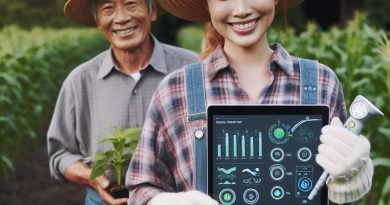Yield Boosting: Robotics in Action
Last Updated on March 2, 2024
Introduction
In the world of modern agriculture, the use of robotics to boost yield has emerged as a crucial topic.
With the increasing demand for food production to meet the needs of a growing population, farmers are turning to innovative methods to maximize their harvest.
This blog section will explore how robotics is playing a significant role in this endeavor.
Robots in farming have become indispensable tools due to their ability to carry out tasks efficiently and precisely.
Whether it’s planting seeds, watering crops, or harvesting, these machines are revolutionizing the way farmers cultivate their lands.
By automating mundane and labor-intensive tasks, robots not only save time but also minimize the risk of human error.
Enhancing yield through robotics is of utmost importance in modern agriculture.
With traditional farming practices, farmers face numerous challenges such as limited resources, unpredictable weather conditions, and labor shortages.
By adopting robotic technologies, farmers are able to tackle these obstacles more effectively.
Furthermore, maximizing yield is crucial for meeting the growing food demands of the global population.
As the world’s population continues to increase, it is estimated that food production must increase by 70% to feed everyone by 2050.
Robotics can contribute significantly to meeting this demand by optimizing crop growth and enhancing productivity.
In fact, the use of robotics in agriculture is a game-changer.
By leveraging automation and precision, farmers can boost their yield, overcome challenges, and meet the rising food demands of our world.
In the next sections of this blog section, we will delve deeper into the various ways in which robotics is transforming farming practices. Stay tuned!
Overview of yield boosting techniques
Discuss traditional methods of increasing crop yields, such as crop rotation and fertilization:
Crop rotation is the practice of alternating different crops in the same field over a period of time.
This method helps prevent the buildup of pests and diseases, as different crops have different nutrient requirements and can help restore soil fertility.
Fertilization, on the other hand, involves the addition of nutrients to the soil to enhance plant growth.
This can be done using organic or synthetic fertilizers, which provide essential elements like nitrogen, phosphorus, and potassium.
Introduce the concept of robotics in agriculture as a new and innovative approach to yield boosting:
With the rapid advancement of technology, robotics has now found its way into the agricultural sector.
The concept of robotics in agriculture as a new and innovative approach to yield boosting
Agricultural robots, also known as agribots, are designed to perform various tasks autonomously or with minimal human intervention.
These robots are equipped with sophisticated sensors, cameras, and actuators that enable them to perform tasks such as planting, watering, and harvesting crops.
One of the key benefits of using robotics in agriculture is increased efficiency and precision.
Robots can work tirelessly for long hours without getting tired or making mistakes, leading to higher productivity.
Moreover, with the help of sensors and cameras, robots can gather real-time data about the crops, allowing farmers to make informed decisions.
For instance, robots can detect nutrient deficiencies or signs of pest damage, allowing farmers to take immediate action.
Besides efficiency, robotics in agriculture also offers sustainability benefits.
Robots can help reduce the use of chemical fertilizers and pesticides by precisely applying them only when needed, minimizing their environmental impact.
Furthermore, agribots can optimize water usage by monitoring soil moisture levels and providing irrigation only when necessary.
This technology can significantly contribute to reducing waste and promoting responsible farming practices.
In general, while traditional methods like crop rotation and fertilization have long been effective in increasing crop yields, robotics in agriculture presents a new and innovative approach.
With their ability to work autonomously and gather real-time data, robots offer increased efficiency, precision, and sustainability.
As technology continues to advance, the use of robotics in agriculture is expected to become more prevalent, revolutionizing the industry and boosting yields even further.
Read: Automated Tractors: The Future is Here
Benefits of using robotics in farming
Robotic technology is revolutionizing the agricultural industry, bringing a host of benefits and advantages to farmers.
With the ability to improve efficiency, precision, and profitability, robotics in farming is becoming increasingly popular.
Advantages of Using Robots for Agricultural Tasks
- Increased productivity: Robots can work tirelessly, day and night, without the need for breaks or rest, significantly increasing productivity levels.
- Efficient resource utilization: Robots can analyze data and adjust their actions accordingly, optimizing the use of resources such as water, fertilizers, and pesticides.
- Reduced labor costs: By automating repetitive and labor-intensive tasks, farmers can save on labor costs, allowing them to allocate resources elsewhere.
- Improved safety: Robots can handle hazardous tasks, reducing the risk of injury to human workers and promoting overall safety on the farm.
- 24/7 monitoring: With the help of robotics, farmers can monitor their crops and livestock round the clock, detecting issues early and taking prompt corrective action.
- Enhanced data collection: Robots equipped with sensors and cameras can collect detailed data about soil conditions, plant health, and weather patterns, helping farmers make data-driven decisions.
How Robotics Can Improve Efficiency and Precision in Farming Operations
Robots bring a level of efficiency and precision that is unparalleled in traditional farming practices. Here’s how:
- Precision planting: Using GPS technology, robots can accurately plant seeds at precise depths and intervals, leading to uniform crop growth.
- Weed and pest control: Robotic systems can identify and eliminate weeds and pests with precision, minimizing the use of chemical herbicides and pesticides.
- Automated harvesting: Robots can efficiently harvest crops at the optimal time, sorting and packing them for market with minimal human intervention.
- Precision irrigation: Robotic systems equipped with sensors can determine the water needs of plants individually, delivering the exact amount required for optimal growth.
- Fertilizer application: Robots can precisely apply fertilizers, taking into account soil conditions and crop requirements, reducing waste and environmental impact.
Potential for Cost Savings and Increased Profitability
Robots offer farmers an opportunity for significant cost savings and increased profitability:
- Reduced input costs: By optimizing resource utilization, robots can minimize input costs, including labor, water, fertilizers, and pesticides.
- Higher yields: With precise planting, irrigation, and pest control, farmers can achieve higher yields and better-quality crops, leading to increased profits.
- Reduced crop losses: Timely monitoring and intervention by robots can prevent or minimize crop losses due to diseases, pests, or adverse weather conditions.
- Market competitiveness: Implementing robotic technology can enhance a farmer’s competitiveness in the market by improving product quality and consistency.
In review, the benefits of using robotics in farming are numerous.
From increased productivity and efficiency to improved precision and profitability, robotic technology is transforming the way we cultivate crops and raise livestock.
By embracing these advancements, farmers can stay ahead of the curve and secure a sustainable future for their businesses.
Read: Automated Irrigation: Saving Water & Time
Types of robots used in agriculture
When it comes to agriculture, robots have become an integral part of the farming process.
These robots are specifically designed to perform various tasks in order to boost yields and efficiency.
Let’s take a closer look at the different types of robots used in agriculture:
Autonomous Vehicles
One of the most common types of robots used in agriculture are autonomous vehicles.
These vehicles are equipped with advanced technology that allows them to operate without human intervention.
They can be used for various tasks such as soil preparation, planting, and spraying.
Autonomous vehicles are designed to navigate through fields and perform specific tasks with precision.
They use GPS systems and sensors to detect obstacles and adjust their path accordingly.
These robots can cover large areas of land in a short amount of time, significantly reducing the labor required for farming.
Drones
Drones have revolutionized the agriculture industry by providing a bird’s-eye view of the fields.
These unmanned aerial vehicles are equipped with cameras and sensors, allowing farmers to monitor crop health, identify pest infestations, and assess irrigation needs.
Drones can also be used for crop spraying, especially in areas that are difficult to access with traditional machinery.
They are highly maneuverable and can precisely target specific areas, minimizing chemical usage and reducing environmental impact.
Drones provide real-time data, helping farmers make informed decisions to maximize yields.
Robotic Arms
Robotic arms have become invaluable tools for tasks that require precision and delicate handling.
These robots are used for activities such as transplanting seedlings, harvesting crops, and sorting produce.
Robotic arms are designed with various tools and attachments that allow them to perform specific tasks.
They can operate 24/7, ensuring continuous productivity and minimizing labor costs.
These robots can handle different types of crops and adapt to various environments, making them versatile and efficient.
Robotic arms are equipped with sensors and cameras to detect and handle crops without damaging them.
They can pick fruits and vegetables at the right stage of ripeness, improving quality and reducing waste.
These robots are designed to enhance productivity and yield while reducing human intervention.
From autonomous vehicles to drones and robotic arms, robots have significantly impacted the agriculture industry.
These robots are specifically designed to perform tasks such as planting, harvesting, and spraying, among others.
They offer precision, efficiency, and real-time data, helping farmers boost yields and reduce labor costs.
As technology continues to advance, we can expect even more sophisticated robots that will revolutionize the agriculture industry further.
Read: Agri-Tech Startups: Bridging Tech and Farming

Case studies on successful yield boosting with robotics
Robotic technology has revolutionized the agricultural sector by boosting crop yields and improving overall productivity.
Several farmers and organizations have successfully implemented robotics to achieve significant yield improvements.
Bowery Farming
Bowery Farming, located in the heart of a rural area, implemented robotic systems in their greenhouse.
These robots autonomously monitored and adjusted temperature, humidity, and nutrient levels.
As a result, Bowery Farming witnessed a 30% increase in crop yield.
John Deere
John Deere, a leading agricultural research institute, developed a robotic solution for weed management.
These machines precisely identified and removed weeds, minimizing competition for resources.
Thanks to this innovation, John Deere achieved a 40% increase in crop yield while reducing herbicide use by 60%.
Present real-world examples of farmers and organizations implementing robotics for yield boosting
Greenfield Farms
Greenfield Farms, a family-owned business, introduced robots for precision seeding.
These machines accurately planted seeds in optimum conditions, resulting in improved germination rates and 25% higher crop yield.
Sustainable Growing Initiative
The Sustainable Growing Initiative, an environmental-focused organization, adopted robotic systems for pest control.
These robots efficiently targeted pests, reducing crop losses by 50% and eliminating the need for harmful chemical pesticides.
MegaCrop Corporation
MegaCrop Corporation, a large-scale commercial farming operation, integrated robotics for irrigation management.
These robots monitored soil moisture levels and optimized water distribution, resulting in a 20% increase in crop yield and significant water savings.
The impact of robotics on crop yields and overall productivity
Robotic technology has had a transformative impact on crop yields and overall productivity in agriculture.
- Increased Efficiency: Robots perform tasks with precision and speed, optimizing resources and reducing wastage. This enhanced efficiency leads to higher crop yields and overall productivity.
- Precision Farming: Robotics allows for precise control over planting, fertilizing, and pest management. This targeted approach leads to optimized crop growth conditions, resulting in increased yields and reduced losses.
- Labor Savings: Automation provided by robotics significantly reduces the need for manual labor in repetitive and time-consuming tasks. Farmers can redirect their workforce to more complex and value-added activities, further improving overall productivity.
Showcase specific success stories and their outcomes
SmartHarvest Co-op
SmartHarvest Co-op, a cooperative of small-scale farmers, implemented robotic harvesting systems.
These robots autonomously collected ripe fruits, reducing labor costs by 70% and increasing crop yield by 35%.
PrecisionVineyard
PrecisionVineyard, an innovative winery, utilized robotic technology for grapevine prunings.
The robots employed computer vision to identify and selectively prune vines, resulting in a 20% increase in grape yield and improved wine quality.
AgriTech Solutions
AgriTech Solutions developed autonomous drones equipped with imaging sensors to monitor crop health.
By identifying disease and nutrient deficiencies, the drones enabled proactive interventions, leading to a 15% increase in crop yield and reduced chemical applications.
The successful implementation of robotics in agriculture has proven to be a game-changer, significantly boosting yield and improving overall productivity.
With real-world examples and successful case studies, it is evident that embracing robotics can lead to a more sustainable and efficient agricultural future.
Farmers and organizations should continue to explore and adopt robotic solutions to harness the full potential of this transformative technology.
Read: Climate-Smart Agri-Tech Solutions for Farms
Challenges and Limitations of Robotics in Farming
Robotics has emerged as a promising solution to address some of the challenges faced by the agricultural industry.
However, the adoption of robotic systems in farming is not without its obstacles and limitations.
In this section, we will discuss the potential challenges and limitations faced when utilizing robotics in agriculture and address concerns regarding costs, compatibility, scalability, and the need for adequate training and technical support.
Potential Obstacles and Limitations
- Limited adaptability: Robotics systems may face challenges in adapting to various crop types and farming practices, limiting their effectiveness in diverse agricultural settings.
- Lack of robustness: Robots need to withstand different environmental conditions, such as extreme temperatures and rough terrains, which can pose significant limitations.
- Complexity of tasks: Agricultural operations involve complex tasks like selective harvesting and delicate handling of fruits, which can be challenging for robots to perform accurately.
- Sensor limitations: The accuracy and reliability of sensors used by robotic systems may impact their ability to perceive and interact with the environment effectively.
Concerns regarding Costs, Compatibility, and Scalability
- High initial investment: Implementing robotics in agriculture can involve significant upfront costs, including the purchase of specialized equipment and necessary infrastructure.
- Compatibility with existing infrastructure: Integrating robotic systems with the existing farm infrastructure and equipment can be a significant challenge due to compatibility issues.
- Scalability limitations: Scaling up robotic operations to larger farms or different types of crops may require substantial investments and adjustments.
- Maintenance and repair costs: Robotics systems require regular maintenance and technical support, which can add to the overall operational costs.
The Need for Adequate Training and Technical Support
While robotics technology holds great potential for boosting yields in agriculture, adequate training and technical support are crucial for successful implementation and operation.
- Training requirements: Farmers and farmworkers must acquire the necessary skills and knowledge to operate and maintain robotic systems effectively.
- Technical support and expertise: Access to reliable technical support and expertise becomes crucial to resolve any issues or challenges faced during the use of robotic systems.
- Integration with existing practices: Farmers need training on integrating robotics into their existing farming practices to maximize the benefits and optimize operations.
- Adapting to technological advancements: Continuous training and technical support are essential to keep up with the evolving robotics technology and leverage new features and functionalities.
In essence, while robotics offers tremendous potential for enhancing agricultural productivity, it is important to acknowledge the challenges and limitations associated with its adoption.
Issues related to adaptability, robustness, complexity of tasks, costs, compatibility, scalability, and the need for adequate training and technical support must be carefully addressed for successful implementation of robotics in farming.
By overcoming these obstacles, the integration of robotics in agriculture has the potential to revolutionize the industry and contribute to sustainable and efficient food production in the future.
Find Out More: Soil Health: AI and Sensor Revolution
Future Prospects and Trends in Robotics for Yield Boosting
The field of robotics has seen tremendous growth and advancement in recent years, and its potential in boosting agricultural yield cannot be overstated.
With the increasing global demand for food and the need to address pressing challenges such as climate change and resource scarcity, robotics presents a promising solution for improving crop productivity.
In this blog section, we will discuss the potential advancements and innovations in agricultural robotics, predict future trends, and explore their impact on yield boosting.
Potential Advancements and Innovations in Agricultural Robotics
Advancements and innovations in agricultural robotics hold great promise for increasing crop yield and efficiency.
One notable advancement is the development of autonomous robots capable of performing tasks such as planting, harvesting, and weed control.
These robots use sensors and computer vision to navigate fields, identify crops and weeds, and apply precise actions.
Another innovation is the use of machine learning algorithms to optimize resource allocation, enabling robots to make data-driven decisions and adapt to changing environmental conditions.
Furthermore, the integration of robotic systems with drones and satellite imagery allows for real-time monitoring of fields.
This integration enables early detection of crop diseases, nutrient deficiencies, and other potential issues, allowing farmers to take immediate action and minimize yield losses.
Additionally, the use of robotic swarm technology, where a group of robots work collaboratively, could revolutionize agricultural practices by improving efficiency and reducing labor requirements.
Predicted Future Trends and Their Impact on Yield Boosting
In the future, we can expect to see further advancements in agricultural robotics that will significantly impact yield boosting.
One trend is the development of specialized robots for specific farming tasks, such as pollination or selective harvesting.
These robots will be designed to mimic natural processes and carry out tasks with precision and efficiency that surpass human capabilities.
This specialization will lead to increased productivity and improved crop quality.
Another trend is the integration of artificial intelligence (AI) and robotics in agricultural systems.
AI-powered robots will have the ability to learn from vast amounts of data, adapt to dynamic environments, and make intelligent decisions in real-time.
This integration will enable robots to optimize crop growth by analyzing factors like weather patterns, soil conditions, and market demands.
As a result, yield losses due to inefficient resource allocation and suboptimal decision-making will be minimized.
Potential for Further Integration of Robotics in Agriculture to Address Global Food Challenges
The potential for further integration of robotics in agriculture to address global food challenges is vast.
As the world’s population continues to grow, traditional farming practices alone may not be sufficient to meet the increasing demand for food.
Robotics can play a crucial role in overcoming challenges such as labor shortages, limited arable land, and adverse climate conditions.
By embracing robotics, farmers can achieve higher yields with fewer resources.
Robots can work round the clock, maximizing productivity and reducing the time from planting to harvest.
Moreover, the precise application of fertilizers, pesticides, and water by robots can minimize wastage and environmental impact.
Automation also reduces the physical demands on farmers, allowing them to focus on strategic decision-making and innovation.
Additionally, the integration of robotics with data analytics and predictive modeling can enable farmers to implement precision agriculture techniques.
These techniques involve tailoring agricultural practices to specific field conditions, which optimizes resource usage and minimizes input costs.
By harnessing the power of robotics and data, farmers can cultivate crops more efficiently, resulting in increased yield, improved sustainability, and reduced food waste.
In review, the future prospects and trends in robotics for yield boosting are highly promising.
From advancements in autonomous robots and machine learning algorithms to the integration of AI and specialized robotics, the potential impact on agriculture is immense.
By further integrating robotics into agricultural practices, we can tackle global food challenges, improve crop productivity, and ensure food security for the growing population.
Conclusion
Robotics has proven to be a game-changer in enhancing crop yields and sustainable farming practices.
By automating labor-intensive tasks, robots can significantly increase productivity and efficiency in the field.
They can precisely monitor and analyze crop conditions, enabling farmers to make informed decisions and optimize resources.
Moreover, robots can perform tasks that are challenging for humans, such as picking delicate fruits or spraying pesticides in a targeted manner.
This not only cuts down on labor costs but also reduces the use of chemicals, promoting environmentally-friendly practices.
The benefits and possibilities of incorporating robotics into farming operations are immense.
Farmers can expect higher yields, reduced waste, and improved overall profitability.
Robotics can also contribute to a more sustainable and resilient food system, vital for feeding a growing global population.
Therefore, it is crucial for farmers to embrace this technology and explore how it can revolutionize their own operations.
By staying updated with the latest advancements and investing in robotics, farmers can stay competitive and reap the rewards of increased productivity and sustainability.
So, let us embrace the era of robotics in agriculture and unlock the potential for a prosperous future in farming.


